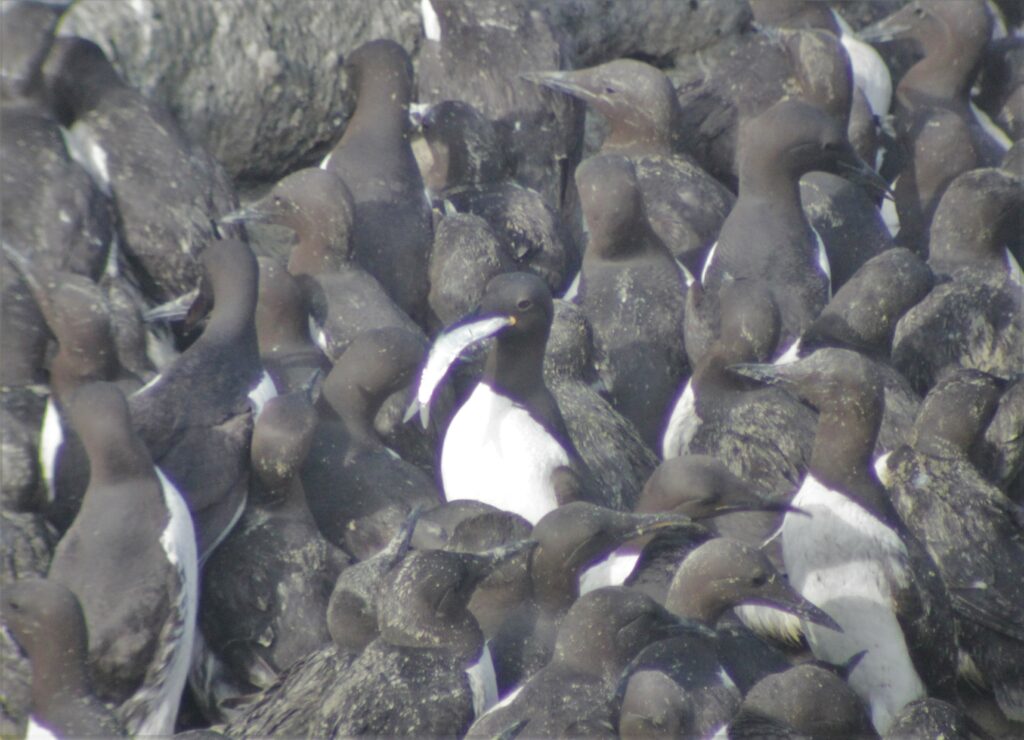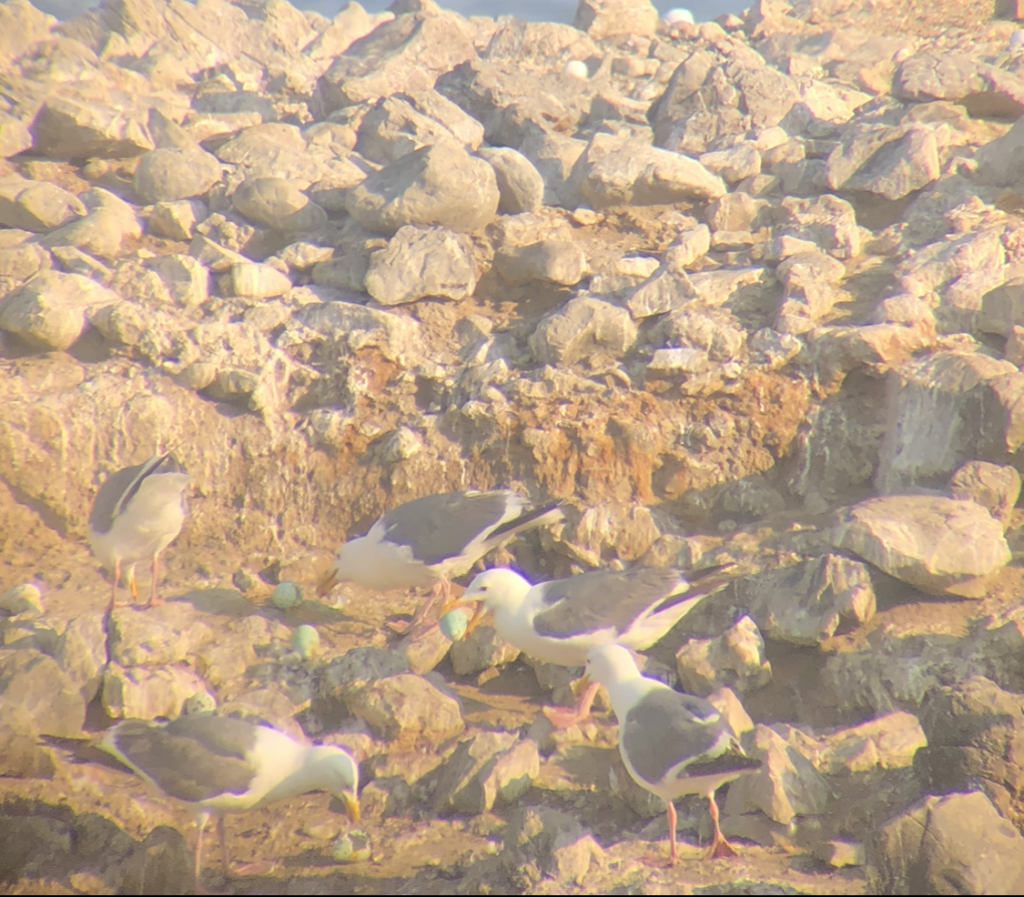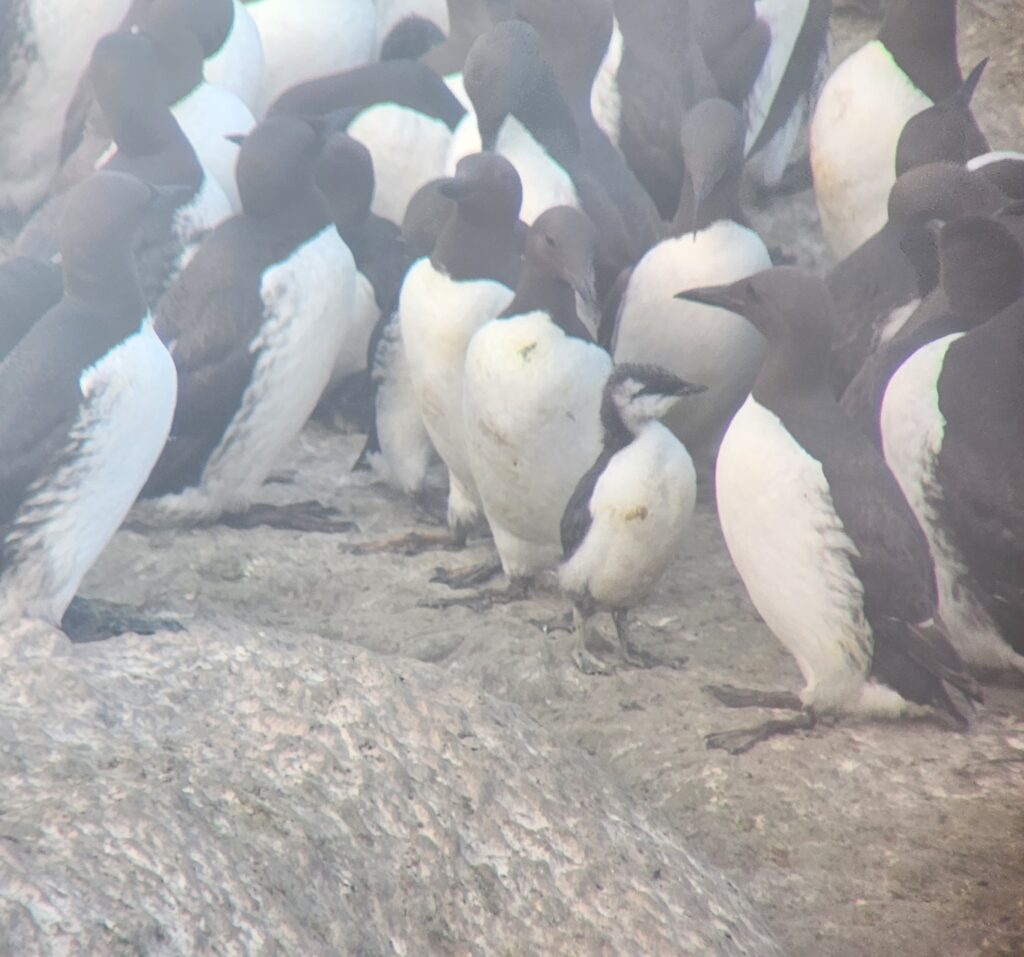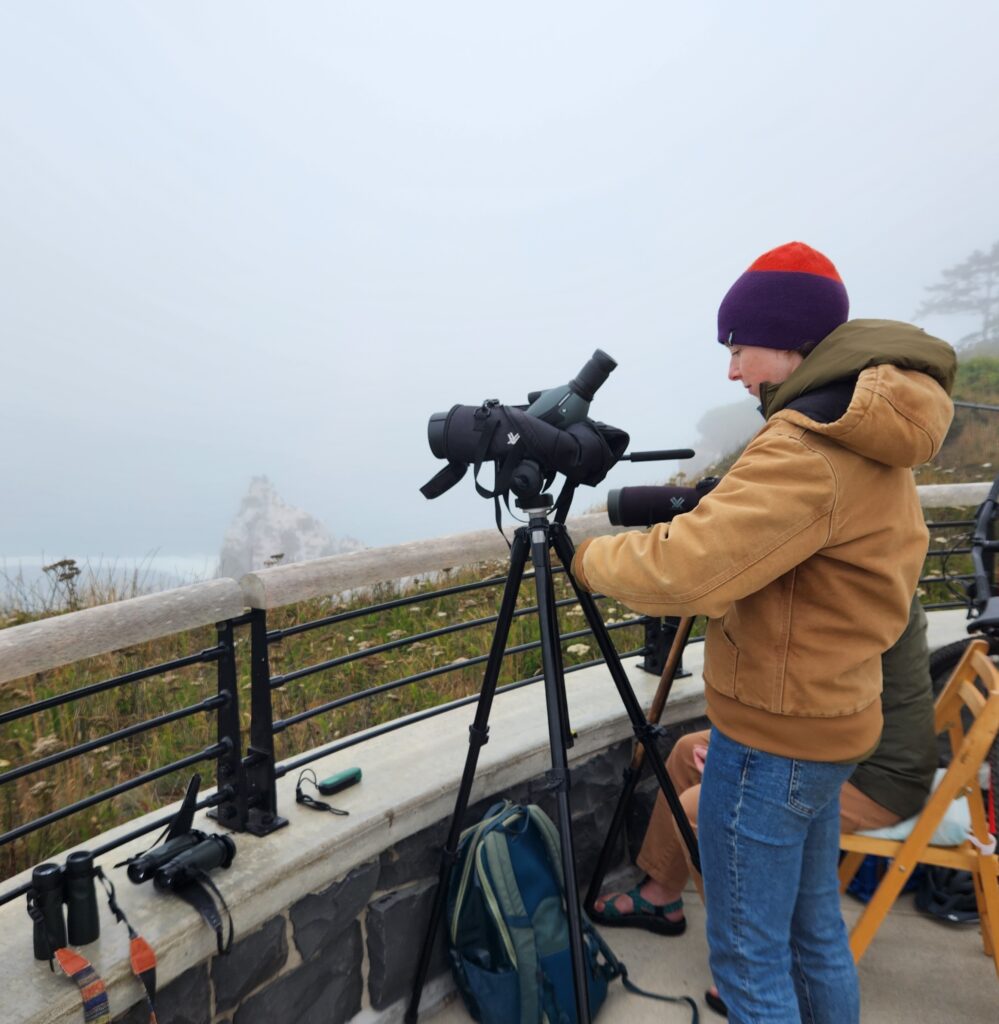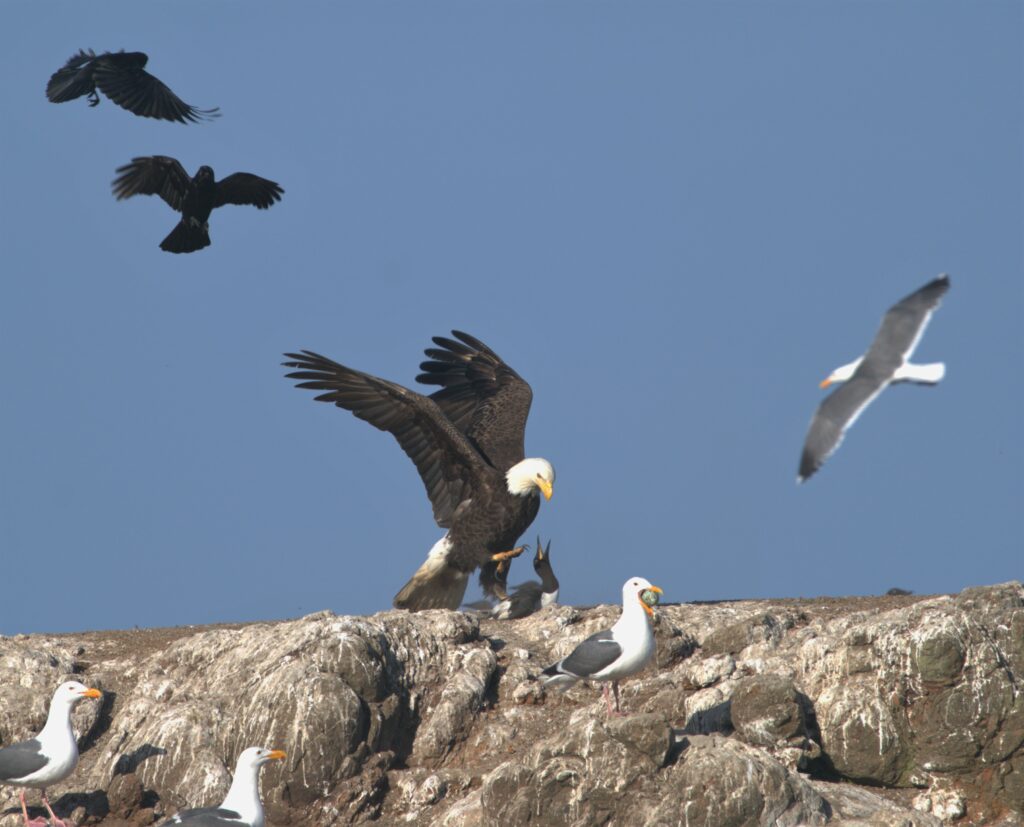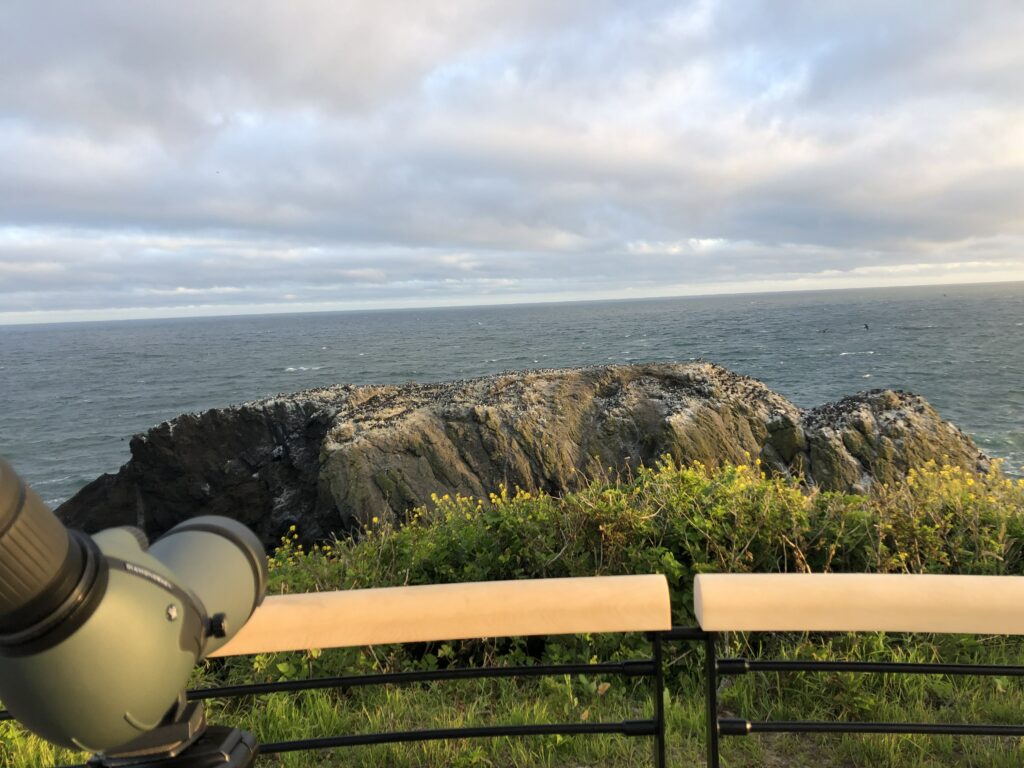Yaquina Head Early Season Update, Summer 2024
It’s the start of another summer on the Oregon Coast and I once again find myself spending most mornings out on rocky headlands for another season of seabird monitoring. Since early May, I’ve been following the breeding activities of murres, cormorants, and gulls at Yaquina Head (Newport) and Pirate Cove (Depoe Bay). As the season begins to take shape, I wanted to share what I’ve been seeing through my spotting scope.
Initial signs are mixed, but seemingly point to a year of low to moderate breeding success for most species. Common Murres have been around the two colonies for months by now, yet occupation of nesting sites has so far only been sporadic. I’ve yet again been observing frequent disturbances by up to four bald eagles at a time, which has prevented the murres from regularly settling into the colony and their nest sites (Figure 1). Because of the frequent eagle activity, I’ve rarely had the opportunity to see murres fully occupy all the Yaquina Head subcolonies; my best guess, however, is that the number of murres attending the colony is lower than at this time last year.
Despite regular disturbances, I observed the first few murre eggs at Yaquina Head on June 6th! While these eggs were predated within a few days, this does indicate that murres are willing to attempt breeding and I suspect more eggs will be seen soon. The ability of murres to breed successfully last year, despite heavy eagle disturbance early on, gives me reason to be cautiously hopeful that at least some Yaquina Head murres will manage to fledge chicks this year. Eagle disturbances appears to be fewer and less severe at Pirate Cove, and I’m eager to see how long the first few murre eggs at that colony persist. Despite the challenges imposed by eagles, murres appear motivated to attempt breeding.

In contrast, Pelagic Cormorants are by and large not attending either the Yaquina Head or Pirate Cove colonies this year. Last summer saw record-high Pelagic Cormorant productivity and each monitored nest fledged an average of 2.8 chicks; however, so far this summer, I’ve only been able to locate a single nest with eggs across our two sites.
Cormorants, generally – and Pelagics, in particular – are known for highly variable reproductive outputs (Figure 2). Some seabirds (e.g., tubenoses) take more of a “low and slow” approach to reproduction that leads to a moderate but fairly consistent output across years, but Pelagic Cormorant reproduction is typified by highly variable, “boom or bust” cycles. Ainley and Boekelheide note in their Seabirds of the Farallon Islands (1990) that Pelagic Cormorants experience the most extreme interannual variation in breeding effort and success of all the seabird species that breed there. Cormorants are sensitive to fluctuations in prey populations and may skip breeding when prey is scarce, but they can also lay large clutches to take advantage of highly favorable conditions.
While 2023 was undoubtedly a “boom” year, 2024 is shaping up to be the accompanying “bust”. Initial monitoring of many well-built nests saw birds abandon nest-guarding early on and relatively few Pelagic Cormorants even appear to be attending the colony. Cormorant reproduction in the California Current System is related to sea surface temperature, with low reproductive effort often associated with warm-water, El Niño periods (Schmidt et al. 2015) like we experienced this last winter.

Brandt’s Cormorants (Figure 3), on the other hand, are attempting to breed this year at both sites. Most are busily incubating three or even four egg clutches now, with the first chicks expected by the end of June. It’s possible that Brandt’s Cormorants finished the winter in better body condition than Pelagics, perhaps because they often exploit different foraging habitats and prey types (Ainley et al. 1981). Brandt’s Cormorant reproduction does tend to be somewhat less variable than that of their cliff-dwelling relatives (Ainley & Boekelheide 1990), but still varies considerably between years in relation to ocean conditions and prey abundance (Schmidt et al. 2015; Ainley et al. 2018). It’s interesting to observe these two congeneric species of seabird respond so differently to these conditions. However, cormorants may also abandon breeding efforts mid-season if prey availability should suddenly decline, so I’ll continue monitoring to see how the Brandt’s manage to do this summer.

As for other species, Western Gulls have been faithfully incubating their two and three egg clutches at both sites for several weeks now – it’s just a matter of time before our first downy chicks of the year are around. The Black Oystercatchers aren’t nesting at easily-visible sites this year, but their raucous calls continue to be a near-constant presence at both colonies. Excitingly, I’ve also observed Tufted Puffins circling the Yaquina Head murre colony on several occasions, and once saw one flying over Pirate Cove! While neither site has much suitable nesting habitat for puffins, the USFWS recently placed puffin decoys and artificial burrows on Gull Rock (located squarely between the Yaquina Head and Pirate Cove colonies) to draw them there. The puffins’ continued interest in these sites continues to raise my hopes that one day soon we’ll have Tufted Puffins nesting again on the Central Coast.
So far, it seems challenging to predict just what kind of year we’ll see on the Oregon Coast. Reduced breeding effort by Pelagic Cormorants and (to a lesser extent) murres, suggests unfavorable conditions. Yet, murres (though perhaps in somewhat lesser numbers) have begun to lay eggs at both sites and Brandt’s are attempting to breed in seemingly typical numbers. I’ll continue to brave the wind and fog to document how this annual drama plays out.
References
Ainley & Boekelheide. 1990. Seabirds of the Farallon Islands: Ecology, Structure, and Dynamics of an Upwelling System Community. Stanford University Press, Stanford, CA, USA.
Ainley et al. 1981. Feeding ecology of marine cormorants in southwestern North America. The Condor 83: 130-131. https://doi.org/10.2307/1367418
Ainley et al. 2018. Ecosystem-based management affecting Brandt’s Cormorant resources and populations in the central California Current region. Biological Conservation 217: 407-418. https://doi.org/10.1016/j.biocon.2017.11.021
Schmidt et al. 2015. Shifting effects of ocean conditions on survival and breeding probability of a long-lived seabird. PloS ONE 10(7): e0132372. https://doi.org/10.1371/journal.pone.0132372


